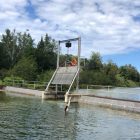
By Clara Lincolnhol
Writer Tamara Dean left the city for a rural life in Wisconsin’s Driftless Area, a region known for dodging the glaciers that carved the landscape of the surrounding states and the Great Lakes 10,000 years ago.

By Kayte Marshall
Hail to the annual produce and food crop festivals. We learn about the Shepherd Maple Syrup Festival and Romeo Peach Festival and talk to Pure Michigan.

By Dylan Engels
The DNR is collecting 4.5 million steelhead eggs at the Little Manistee River Weir in Manistee County. Most are incubated at the Thompson State Hatchery in Manistique and the Wolf Lake State Hatchery in Mattawan for release next spring.

By Dylan Engels
Fishing licenses for the year are available, and DNR has changed a few requirements. We talk to experts from the Platte River Hatchery in Beulah, DNR and Michigan United Conservation Clubs.
More Headlines




